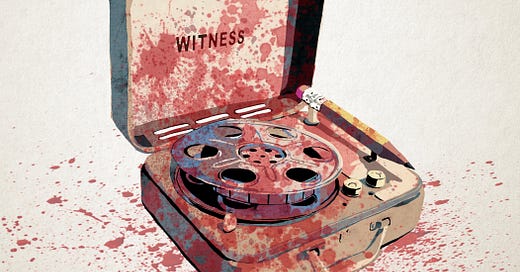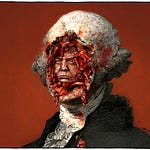Narrated by Eunice Wong
Text originally published July 22, 2023
Witness - by Mr. Fish
Films about war, shorn of the bone crushing fear, the putrid stench of the corpses, the deafening noise of explosions, the constant exhaustion and the nervous anxiety that comes with trying to understand what is happening in the terrifying chaos, are pale and inadequate reflections of the vast enterprise of industrial slaughter. And these are the good films, of which there are only a few.
Most feature war films and documentaries, from The Sands of Iwo Jima to Saving Private Ryan, are war pornography. They romanticize those wielding the terrible instruments of death. They justify the unjustifiable. They pay homage to the war machine. They entice naïve young men and women into becoming cannon fodder. They distort the public’s perception of war, leaving those who return from war and attempt to speak the awful truth alienated and ignored.
Those in war who do the fighting, endowed with a god-like power to kill, are a minority. The real face of war is the hardship and grief suffered by civilians caught up in the maw of destruction. Their stories are hard to hear. Their fate is hard to see, which is why images from war are always sanitized. If we truly saw war, it would be so shocking, so disturbing, so disgusting, war would be hard to wage. The best accounts of war, for these reasons, eschew scenes of combat.
The documentary “20 Days in Mariupol,” a chronicle of the first 20 days of Russia’s invasion of Ukraine, captures what I witnessed as a war correspondent in Central America, the Middle East, Africa and the Balkans. It fails, as all films about war must fail, but it succeeds where few films about war succeed. It relentlessly rips back the veil on war - fatally wounded children and pregnant women torn apart by shell fragments; the frantic and doomed efforts of doctors to save them; the shrieks and lamentations of those cradling the bloodied bodies of the dead; the collapse of the social order once the fragile structures of a civil society cease to exist and looting and pillage become a way to survive. In war there are only predators and prey.
War is ugly and tawdry. Violence creates nothing. It only destroys — human beings, animals, schools, homes and apartment blocks, hospitals, bridges. It is the purest expression of death. All the forces that nurture and sustain life — familial, civil, social, cultural, ecological — are slated for obliteration.
Associated Press video journalist Mstyslav Chernov and his colleagues, photographer Evgeniy Maloletka and producer Vasilisa Stepanenko, documented the first three weeks of the Russian assault on the port city of Mariupol. The three Ukrainian reporters were the only ones from a foreign news agency to remain in the city. The movie draws from 25 hours of film, only 40 minutes of which were transmitted to the AP editors. Much of the footage, even if it could all have been transmitted, would never have been disseminated. It is too graphic.
The film focuses exclusively on Russian atrocities. It ignores those committed by Ukrainians. I covered enough wars to know there were some. The neo-Nazi Azov Regiment, and other fascist-inspired militias, played a major role in the fighting in Mariupol. These militias have been accused of terrorizing and executing ethnic Russians and those suspected of sympathizing or working with separatists. The Azov Regiment’s symbol is a black “Wolfsangel,” an emblem used by Nazi units in World War II. The regiment embraces the fascist ideology of blood and soil. The fascist militias are absent in the film. This is by design. The journalists do not address the plight of ethnic Russians, although Mariupol is a largely Russian-speaking city. While most in the city consider themselves to be Ukrainian, almost half also identify as Russian. These ethnic Russians usually blame the war in the Donbas, which has been raging since 2014 and where the city is located, on the government in Kyiv.
What happened to the ethnic Russians and separatists the Ukrainians considered collaborators? Were Ukrainian military units using hospitals as bases of operations in violation of the Geneva Conventions? There were scenes of armed Ukrainian soldiers in hospital corridors. The documentary leaves these questions unanswered.
It is not that what we see in the film is not true. Rather, it is that the film omitted what would not reflect well on Ukraine. When you depend on military units for protection and logistics you censor your reporting. If the reporters had reported on the abuses and atrocities carried out by Ukrainian units the protection they received would have been withdrawn. As much as I admire the documentary, the lie of omission is still a lie. It is the most common lie told in war. Only reporters who dare to report without embedding in military units are free to report the truth. But this is very dangerous and lonely work. This willful self-censorship is a serious flaw in the film, but it does not distract from the power of the visceral footage or the courage of the reporters.
There are almost no scenes of combat other than the burning remains of an anti-aircraft battery, the thud and explosion of Russian shells, the billows of black smoke, the roar of Russian jets, the distant rattle of machine guns and the occasional Ukrainian soldier firing down a deserted street.
The film, as all films about war should, focuses on the human detritus. We see elderly men and women, who have lost their homes and possessions, boiling snow to get water. We see bewildered civilians huddled in basements. We see the shelling of a maternity hospital and graphic pictures of wounded and dead pregnant women. We see the frantic efforts, which fail, to save gravely wounded children, including a 4-year-old girl named Evangelina. We see the wailing mothers and fathers who clutch the bodies of their dead children, kissing them one last time before wrapping up their small, pale corpses. We see the rows of corpses in the hospital basement. We see the tears of medics and doctors as they struggle fruitlessly to save lives. We see the heroic work of firefighters and then we see some of their dust covered lifeless bodies in the bombed out remains of their firehouse. We see the freshly dug trenches where the dead, including those of children, are piled one on top of the other, at first wrapped in green garbage bags and later dumped unceremoniously into the pit as exposed corpses.
“War is like an X-ray: all human innards are visible,” a doctor says in the film. “Good people become better. Bad people become worse.”
We also see the daily life of war reporters. Reporters intrude into the lives of those who have undergone unspeakable tragedies and trauma. Many of those filmed feel as if they are being treated by the press like exotic zoo animals, on display for cameras and foreign audiences. They spit venom at the reporters. “Prostitutes,” one enraged father snaps at the journalists. There is a mercenary quality to our work, however important it is to tell the story. While we chronicle the horror we are usually numb, although what we see and hear comes back to haunt us, especially at night, for the rest of our lives.
By the 11th day of the assault, with the Russians blockading the city from all three sides, the AP journalists must, at great risk, defy the curfew to hunt for a wireless connection. The life of a war reporter is consumed by these kinds of logistics, trying to get from one location to the next, trying to find out what is happening, trying to get a satellite or cell phone connection so pictures and reports can be sent.
War reporters have a privileged status. We have powerful institutions that support us. We do not go hungry. We have body armor and armored cars. Those with far less protection and resources ensure we are protected and evacuated so the story can be told. Reporters and photographers, of course, can be wounded and killed. But our chances of survival are enhanced by our status. Volodymyr, a police officer, takes tremendous risks to help extract the AP journalists from a hospital surrounded by the Russian forces. He assists the journalists in escaping the city with their footage. We accept this status. We rationalize to ourselves that we deserve it. But we also are acutely aware that those whose stories we tell are often abandoned and that no matter the risks, no matter how many atrocities we document the world is largely indifferent. By the time the Russians took Mariupol an estimated 25,000 people were dead.
“Thousands have died,” says Chernov, who narrates the film. “We keep filming, but everything stays the same.” He refers to the forlorn hope of Volodymyr, who said that “the image of a dead child will change the war, but we have seen so many deaths, how can we change anything?”
War reporters live with profound shame and guilt, as Chernov admits in the film. Few war reporters are neutral observers. We take the risks we take because we want justice. We want those who ordered and committed these crimes to be held accountable. Stories I wrote for The New York Times documenting Bosnian Serb atrocities were used as evidence in the International Court in the Hague to prosecute war criminals. This is why I wrote them. Chernov says in the film that he hopes one day his images will also bring some of the perpetrators to justice.
There is a brief clip of the Russian Foreign Minister, Sergey Lavrov, claiming that the images transmitted by the AP reporters from the bombed maternity hospital in Mariupol were staged, carried out by actors.
Brazen lies are always the official answer to the crimes we expose. The Israeli government has turned lying into an art form. Israeli soldiers indiscriminately murder Palestinian civilians, including children, and blame the Palestinians for their own deaths or Hamas for using them as human shields or insist the civilians were combatants. During the war in Sarajevo the besieging Bosnian Serbs tried to float the lie that Bosnian army snipers in Sarajevo were killing their own civilians to garner international support, as if a city being peppered with constant sniper fire and hundreds of shells a day lacked adequate numbers of wounded and dead.
The film is mostly chronological. Each day is documented as the Russian forces tighten the noose. Those interviewed in earlier parts of the film appear later, sometimes as corpses. Death is a constant companion. You look for someone, even a friend, and find out they no longer exist. The film does a masterful job of communicating the randomness of death, the indiscriminate fury of modern weapons and the helplessness of those caught in war’s blood-soaked embrace. It isn’t war. But it comes as close as you can get.














Share this post